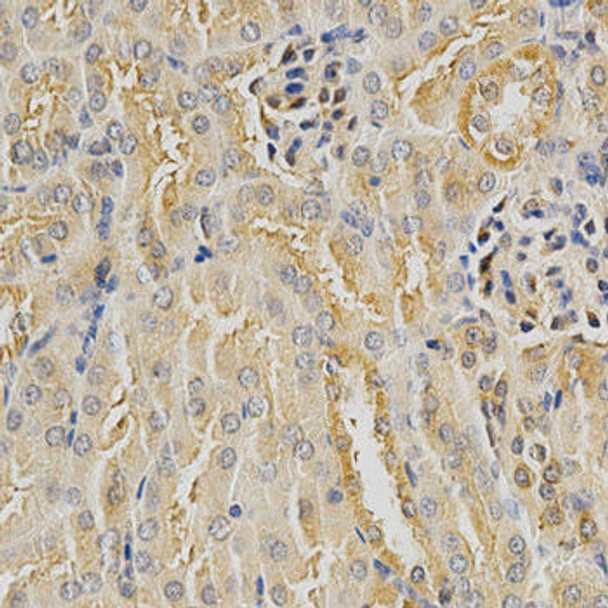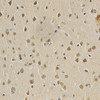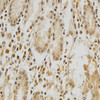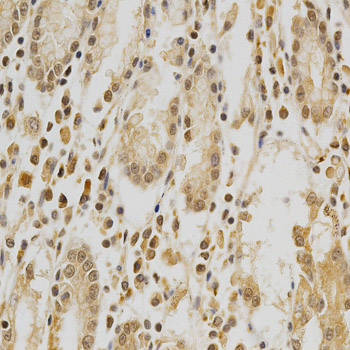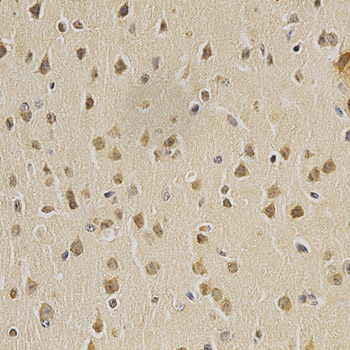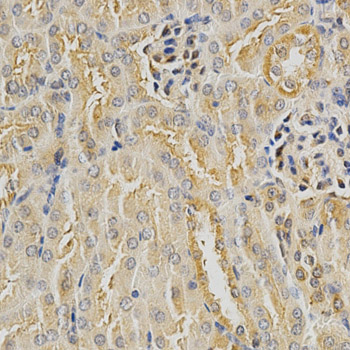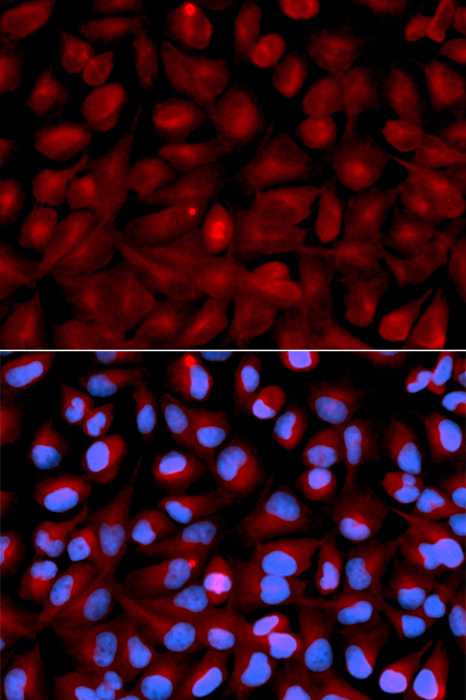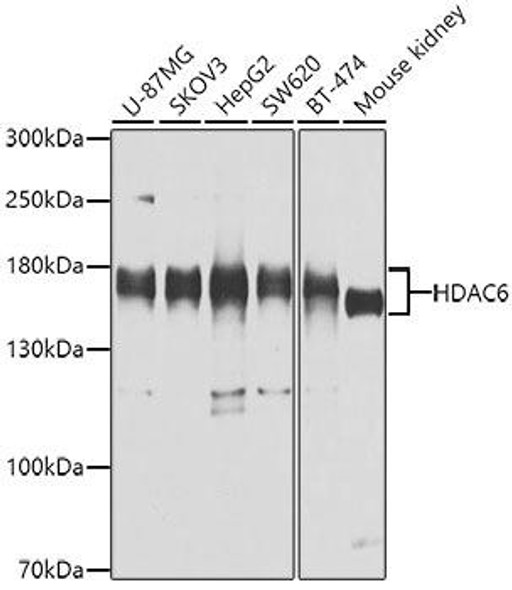Anti-HDAC6 Antibody (CAB11429)
- SKU:
- CAB11429
- Product Type:
- Antibody
- Reactivity:
- Human
- Mouse
- Host Species:
- Rabbit
- Isotype:
- IgG
- Antibody Type:
- Polyclonal Antibody
- Research Area:
- Autophagy
Description
Anti-HDAC6 Antibody (CAB11429)
The HDAC6 Polyclonal Antibody (CAB11429) is a valuable tool for researchers studying HDAC6, a key enzyme involved in regulating cell processes such as cell migration, apoptosis, and autophagy. This antibody, produced in rabbits, is highly specific to human samples and has been validated for use in Western blot applications. By binding to the HDAC6 protein, this antibody allows for the detection and analysis of HDAC6 in various cell types, making it ideal for experiments in cell biology and cancer research.HDAC6, or histone deacetylase 6, plays a crucial role in the acetylation and deacetylation of proteins involved in cellular functions.
Dysregulation of HDAC6 has been implicated in various diseases, including cancer, neurodegenerative disorders, and inflammatory conditions. By studying the role of HDAC6, researchers can gain insight into disease mechanisms and potentially identify new therapeutic targets for intervention.Overall, the HDAC6 Polyclonal Antibody (CAB11429) is a valuable tool for researchers seeking to understand the function of HDAC6 and its implications in cellular processes and disease development. Its high specificity and reliability make it a trusted choice for immunology, oncology, and cellular biology studies.
| Antibody Name: | Anti-HDAC6 Antibody |
| Antibody SKU: | CAB11429 |
| Antibody Size: | 20uL, 50uL, 100uL |
| Application: | IHC IF |
| Reactivity: | Human, Mouse |
| Host Species: | Rabbit |
| Immunogen: | Recombinant fusion protein containing a sequence corresponding to amino acids 160-470 of human HDAC6 (NP_006035.2). |
| Application: | IHC IF |
| Recommended Dilution: | IHC 1:50 - 1:200 IF 1:50 - 1:200 |
| Reactivity: | Human, Mouse |
| Positive Samples: |
| Immunogen: | Recombinant fusion protein containing a sequence corresponding to amino acids 160-470 of human HDAC6 (NP_006035.2). |
| Purification Method: | Affinity purification |
| Storage Buffer: | Store at -20'C. Avoid freeze / thaw cycles. Buffer: PBS with 0.02% sodium azide, 50% glycerol, pH7.3. |
| Isotype: | IgG |
| Sequence: | NEGE LRVL ADTY DSVY LHPN SYSC ACLA SGSV LRLV DAVL GAEI RNGM AIIR PPGH HAQH SLMD GYCM FNHV AVAA RYAQ QKHR IRRV LIVD WDVH HGQG TQFT FDQD PSVL YFSI HRYE QGRF WPHL KASN WSTT GFGQ GQGY TINV PWNQ VGMR DADY IAAF LHVL LPVA LEFQ PQLV LVAA GFDA LQGD PKGE MAAT PAGF AQLT HLLM GLAG GKLI LSLE GGYN LRAL AEGV SASL HTLL GDPC PMLE SPGA PCRS AQAS VSCA LEAL EPFW EVLV RSTE TVER DNME EDNV EESE EEGP WEPP VLP |
| Gene ID: | 10013 |
| Uniprot: | Q9UBN7 |
| Cellular Location: | Cell projection, Cytoplasm, Nucleus, Perikaryon, axon, dendrite |
| Calculated MW: | 114kDa/131kDa |
| Observed MW: |
| Synonyms: | HDAC6, CPBHM, HD6, JM21, PPP1R90 |
| Background: | Histones play a critical role in transcriptional regulation, cell cycle progression, and developmental events. Histone acetylation/deacetylation alters chromosome structure and affects transcription factor access to DNA. The protein encoded by this gene belongs to class II of the histone deacetylase/acuc/apha family. It contains an internal duplication of two catalytic domains which appear to function independently of each other. This protein possesses histone deacetylase activity and represses transcription. |
| UniProt Protein Function: | HDAC6: Responsible for the deacetylation of lysine residues on the N-terminal part of the core histones (H2A, H2B, H3 and H4). Histone deacetylation gives a tag for epigenetic repression and plays an important role in transcriptional regulation, cell cycle progression and developmental events. Histone deacetylases act via the formation of large multiprotein complexes. Plays a central role in microtubule-dependent cell motility via deacetylation of tubulin. Interacts with CBFA2T3, HDAC11 and SIRT2. Interacts with F-actin. Interacts with BBIP10. Under proteasome impairment conditions, interacts with UBD via its histone deacetylase 1 and UBP-type zinc-finger regions. Interacts with CYLD. Interacts with ZMYND15. Belongs to the histone deacetylase family. HD type 2 subfamily. |
| UniProt Protein Details: | Protein type:Ubiquitin conjugating system; EC 3.5.1.98; Nuclear receptor co-regulator; Deacetylase Chromosomal Location of Human Ortholog: Xp11.23 Cellular Component: microtubule; dendrite; histone deacetylase complex; leading edge; perikaryon; caveola; inclusion body; cytosol; nucleoplasm; dynein complex; microtubule associated complex; axon; perinuclear region of cytoplasm; cytoplasmic microtubule; cytoplasm; nucleus Molecular Function:zinc ion binding; microtubule binding; histone deacetylase binding; beta-catenin binding; beta-tubulin binding; Hsp90 protein binding; misfolded protein binding; actin binding; NAD-dependent histone deacetylase activity (H3-K9 specific); protein binding; enzyme binding; NAD-dependent histone deacetylase activity (H3-K14 specific); tubulin deacetylase activity; ubiquitin protein ligase binding; NAD-dependent histone deacetylase activity (H4-K16 specific); histone deacetylase activity; polyubiquitin binding; tau protein binding; alpha-tubulin binding Biological Process: negative regulation of proteolysis; response to misfolded protein; protein polyubiquitination; transcription, DNA-dependent; ubiquitin-dependent protein catabolic process via the multivesicular body pathway; positive regulation of signal transduction; regulation of fat cell differentiation; macroautophagy; negative regulation of microtubule depolymerization; response to toxin; organelle organization and biogenesis; misfolded or incompletely synthesized protein catabolic process; histone deacetylation; regulation of gene expression, epigenetic; response to organic substance; intracellular protein transport; protein complex disassembly; lysosome localization; protein amino acid deacetylation; negative regulation of oxidoreductase activity; regulation of receptor activity; negative regulation of transcription, DNA-dependent; negative regulation of protein complex disassembly Disease: Chondrodysplasia With Platyspondyly, Distinctive Brachydactyly, Hydrocephaly, And Microphthalmia |
| NCBI Summary: | Histones play a critical role in transcriptional regulation, cell cycle progression, and developmental events. Histone acetylation/deacetylation alters chromosome structure and affects transcription factor access to DNA. The protein encoded by this gene belongs to class II of the histone deacetylase/acuc/apha family. It contains an internal duplication of two catalytic domains which appear to function independently of each other. This protein possesses histone deacetylase activity and represses transcription. [provided by RefSeq, Jul 2008] |
| UniProt Code: | Q9UBN7 |
| NCBI GenInfo Identifier: | 205371758 |
| NCBI Gene ID: | 10013 |
| NCBI Accession: | Q9UBN7.2 |
| UniProt Secondary Accession: | Q9UBN7,O94975, Q6NT75, Q7L3E5, Q96CY0, |
| UniProt Related Accession: | Q9UBN7 |
| Molecular Weight: | 114,361 Da |
| NCBI Full Name: | Histone deacetylase 6 |
| NCBI Synonym Full Names: | histone deacetylase 6 |
| NCBI Official Symbol: | HDAC6 |
| NCBI Official Synonym Symbols: | HD6; JM21; CPBHM; PPP1R90 |
| NCBI Protein Information: | histone deacetylase 6; protein phosphatase 1, regulatory subunit 90 |
| UniProt Protein Name: | Histone deacetylase 6 |
| UniProt Gene Name: | HDAC6 |
| UniProt Entry Name: | HDAC6_HUMAN |



